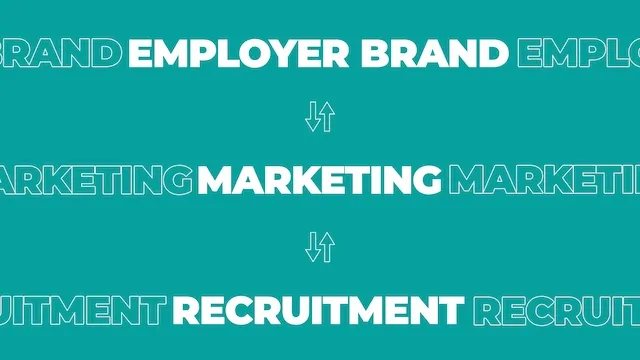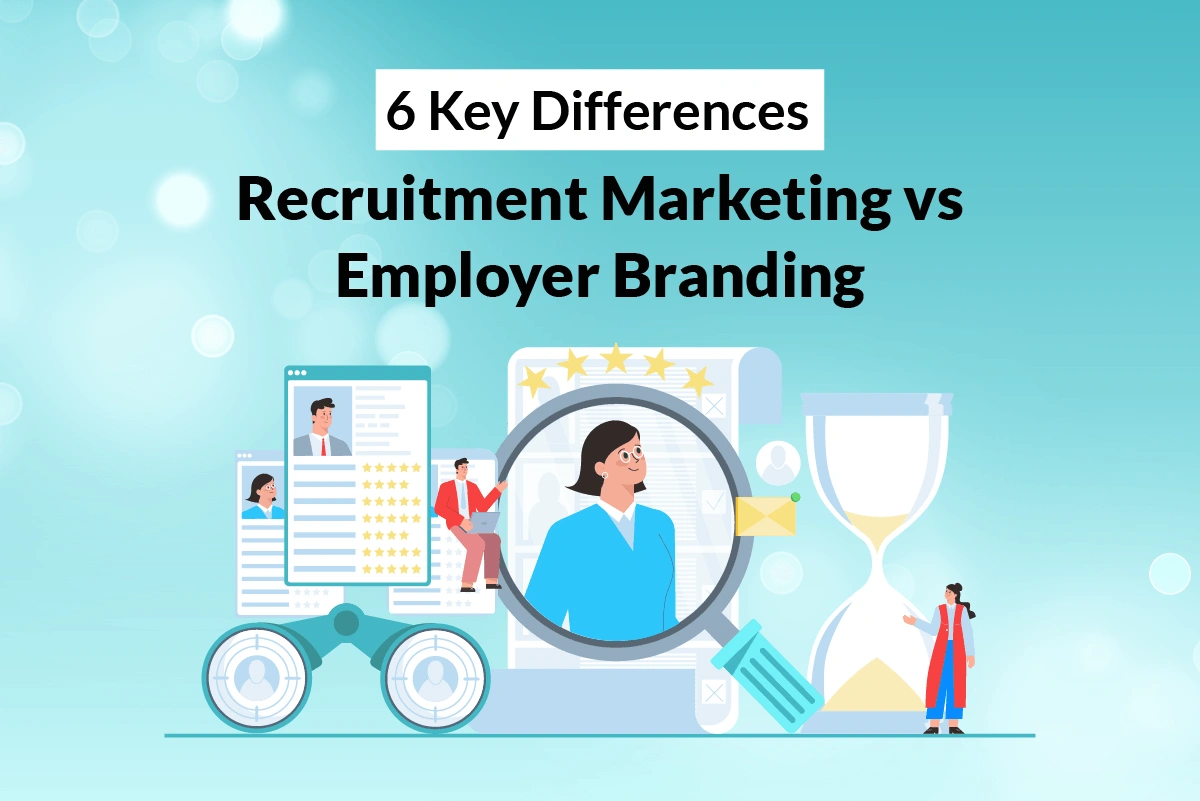In today’s hypercompetitive job market, standing out to top candidates requires more than posting job ads — it demands a clear, compelling employer presence. Yet many companies confuse recruitment marketing with employer branding, treating them as interchangeable when they play very different roles in attracting talent. Recruitment marketing drives awareness and applications in the short term, while employer branding builds long-term reputation, trust, and loyalty. Understanding how these strategies work together is crucial if you want to attract high-quality candidates, reduce cost-per-hire, and strengthen retention. In this guide, we’ll break down the key differences, explore how they intersect, and show you how mastering both can give your organization a competitive hiring edge.
This article will help you consider each term to grasp what these concepts mean and learn how to employ them effectively.
What Is Recruitment Marketing (and Why It Drives Top Talent)

Source: LinkedIn
Recruitment Marketing Definition and Purpose for Talent Acquisition
Recruitment marketing is the proactive strategy of promoting your organization to potential candidates long before they apply. Rather than waiting for talent to come to you, recruitment marketing builds a steady candidate pipeline by positioning your company as an employer of choice.
According to HR.com’s State of Employer Branding 2025 survey, 77% of organizations now consider employer branding and recruitment marketing to be at least moderately important to their overall HR strategy, yet only 28% have a comprehensive, consistently applied approach. This gap represents a massive opportunity. By intentionally managing how candidates perceive your company, you can stand out in a crowded market, attract top talent more effectively, and reduce the time and cost of hiring.
In essence, recruitment marketing blends traditional marketing techniques—storytelling, brand positioning, multi-channel campaigns—with talent acquisition goals. The focus shifts from selling products to selling the employee experience, values, and culture that make your company worth joining.
How Recruitment Marketing Works in the Recruitment Funnel
Recruitment marketing operates at the top and middle of the recruitment funnel, where awareness and interest are built. It starts well before candidates submit applications, nurturing passive talent into active applicants.
For example, HR.com found that well-branded organizations are 3.5X more likely to have a formal employer branding strategy and 2.6X more likely to build and nurture talent communities. These communities act as warm candidate pools—people who are already familiar with your brand and engaged with your content—so when roles open, you can recruit from a trusted network rather than starting from scratch.
Tactically, recruitment marketing uses career sites, social media campaigns, employee testimonials, and targeted job ads to guide candidates from the awareness stage into active engagement. As candidates progress down the funnel, they’re more likely to apply, convert, and ultimately accept offers because they already feel connected to your organization’s story.
Benefits of Recruitment Marketing for Employers
When implemented strategically, recruitment marketing can transform hiring outcomes. HR.com’s 2025 report shows that well-branded organizations are 3.6X more likely to enhance employee engagement and 2.4X more likely to dedicate sufficient resources to branding, leading to stronger hiring performance overall.
Here are key benefits for employers:
- Attract Top Talent More Efficiently
By amplifying your employer brand, you position your company as a destination workplace. This increases applicant quality while reducing reliance on cold outreach or expensive third-party recruiters. - Improve Hiring Outcomes and Retention
Candidates who join because they connect with your culture are more likely to stay. HR.com found that organizations with strong employer brands see higher retention and engagement, reducing the costly cycle of turnover. - Lower Cost Per Hire
Well-branded employers save both time and money because they fill roles faster and with fewer hiring missteps. This efficiency allows HR teams to reallocate time toward strategic initiatives rather than repetitive sourcing.
Ultimately, recruitment marketing is no longer optional—it’s a competitive necessity. In today’s market, candidates evaluate employers as carefully as employers evaluate them. Building a visible, values-driven employer brand ensures your organization stands out and wins the best talent.
What Is Employer Branding (and Why It Matters for Talent Acquisition)

Source: EKRUT
Employer Branding Definition and Core Components
Employer branding is your company’s reputation as a workplace — it’s how current employees, past employees, and potential candidates perceive you. While consumer branding sells your product, employer branding sells your employee experience.
According to HR.com’s State of Employer Branding 2025 report, 62% of HR leaders rate their employer brand as above average or excellent at enhancing company reputation. However, far fewer say it’s effective in critical HR areas such as talent attraction (44%), employee engagement (43%), and retention (42%). This gap highlights why simply being known is not enough — organizations must also be known for being a great place to work.
In short, your employer brand is the story people tell about working at your company when you’re not in the room. It reflects your values, leadership, culture, growth opportunities, and how you treat people — and it directly shapes whether high-quality candidates want to join your team.
How Employer Branding Improves Retention and Engagement
Today’s candidates research employers as carefully as they research major purchases. HR.com found that 78% of organizations recognize employer branding as at least moderately important to their overall HR strategy, yet 40% still lack a formal strategy to manage it. That disconnect creates a competitive advantage for employers who invest in building and protecting their reputation.
Indeed, strong employer branding drives measurable business impact. HR.com’s 2025 study revealed that well-branded companies are 3.6X more likely to enhance employee engagement, 2.4X more likely to dedicate sufficient resources to branding, and over 2X less likely to face leadership disinterest as a barrier. These companies also report stronger performance on DEIB, employee retention, and talent attraction metrics.
Put simply, employer branding does double duty:
- Externally, it attracts top talent by showcasing your values, work environment, and employee success stories.
- Internally, it boosts engagement, inspires advocacy, and improves retention by giving employees a sense of pride and purpose.
When done well, employer branding becomes your competitive edge in the war for talent — making candidates more likely to apply, accept offers, and stay.
Even if you’re a smaller company, you can still build a powerful employer brand that attracts top talent — here’s how small businesses can build a strong employer brand to compete with larger employers.
Key Employer Branding Channels and Strategies
Because employer branding spans multiple channels, consistency is critical. HR.com found that well-branded organizations are 3.5X more likely to have a comprehensive, consistently implemented employer branding strategy than less-branded ones.
Leading employers use a mix of:
- Career sites (rated the most successful by 62% of companies)
- Major job boards like LinkedIn and Indeed (both at 68% as top sources of hires)
- Social media campaigns (used by 52% to showcase culture in real-time)
- Employee testimonials and referrals (72% use referrals as a primary brand amplifier)
- Industry events, job fairs, and talent communities (used by 44% of well-branded companies)
Indeed, every touchpoint reinforces the brand story. Thus, by curating consistent, authentic content across these platforms, employers can strengthen their visibility, credibility, and emotional connection with candidates.
The Bottom Line
While many companies still treat employer branding as a marketing side project, the data is clear: organizations with strong employer brands consistently outperform their peers in hiring, retention, and engagement.
Building that reputation takes intention — but the payoff is lasting. Companies that invest in employer branding don’t just hire faster; they build stronger, more loyal teams that drive business growth.
Recruitment Marketing vs Employer Branding: Key Differences

Source: Lets Evolve
Although the two are closely related, recruitment marketing and employer branding serve different (and complementary) purposes in talent acquisition. Understanding where each fits — and how they work together — will help you build a scalable, measurable hiring engine.
Comparing Recruitment Marketing vs Employer Branding Goals and Metrics
|
Aspects |
Recruitment Marketing |
Employer Branding |
Primary Goal | Generate awareness, interest, and applications for open and upcoming roles | Shape your reputation as a workplace and build long-term trust |
Time Horizon |
| Long-term, always-on, culture-led |
Audience | Active & passive candidates in your recruitment funnel | Candidates, employees, alumni, and the broader market |
Core Content | Job ads, landing pages, talent nurture emails, social campaigns | Employee stories, values, EVP, culture content, leadership POV |
Main Channels | Job boards, programmatic ads, social, email, talent communities | Career site, review sites, PR/communications, social, internal channels |
Primary KPIs | Source of hire, CTR, apply rate, time-to-hire, cost-per-hire | Retention, engagement, offer-accept rate, review ratings, brand sentiment |
Ownership | Typically Talent Acquisition with Marketing support | Split across HR + Marketing + Comms + Leadership |
From HR.com’s State of Employer Branding 2025: 78% of organizations say employer branding is at least moderately important to HR’s strategy, yet only 28% have a comprehensive, consistently implemented approach — a clear opportunity to gain advantage.
Messaging and Channels: How Recruitment Marketing Activates Your Employer Brand
Employer branding lays the foundation for how people perceive your company, but recruitment marketing brings that brand to life across candidate-facing channels. While your employer brand shapes your reputation, recruitment marketing uses targeted messaging and campaigns to push that reputation out to the right talent.
To start, create content that highlights your employer value proposition (EVP)—such as career growth opportunities, DEIB commitments, and workplace culture. Then, distribute it through the most impactful channels:
- Career sites and job boards – These are often a candidate’s first touchpoint and should reflect your employer brand with engaging copy, visuals, and testimonials.
- Social media platforms – Platforms like LinkedIn, Instagram, and TikTok allow you to share authentic day-in-the-life stories, company updates, and employee spotlights.
- Employee advocacy programs – Encourage current team members to share job openings and workplace stories, amplifying trust and reach.
- Email campaigns and talent communities – Nurture passive candidates with ongoing branded content to keep them warm for future opportunities.
HR.com’s 2025 Employer Branding Report found that well-branded organizations are 2.6X more likely to use talent communities and 3.5X more likely to have a consistently implemented branding strategy than their less-branded peers. That consistency builds familiarity, which is critical to converting awareness into applications.
How Employer Branding Supports Long-Term Talent Acquisition Strategy
While recruitment marketing drives short-term applications, employer branding fuels sustainable talent acquisition. A strong employer brand builds long-term trust, loyalty, and candidate interest, creating a continuous talent pipeline that accelerates future hiring cycles.
According to HR.com, organizations with strong employer branding are:
- 3.6X more likely to boost employee engagement
- 2X more likely to report high retention rates
- Over 2X less likely to cite lack of leadership buy-in as a barrier
Thus, these results prove that investing in employer branding pays off far beyond filling current openings. It improves employee advocacy, enhances internal culture, and ensures your organization stays top of mind for high-quality talent—even before they’re actively job seeking.
How to Combine Recruitment Marketing and Employer Branding for Maximum Impact
When combined strategically, employer branding and recruitment marketing amplify each other. Think of employer branding as the “why” and recruitment marketing as the “how.” Your brand defines why candidates should want to work with you, while your recruitment campaigns deliver that message to them at scale.
This integrated approach strengthens your competitive advantage by:
- Aligning brand voice across all candidate touchpoints
- Creating consistent, memorable candidate experiences
- Increasing conversion rates from awareness to application
- Reducing reliance on paid job ads over time
As LinkedIn’s Future of Recruiting 2025 report notes, companies that unify employer branding and recruitment marketing are 50% faster at attracting quality candidates than those running siloed efforts.

Aligning Employer Brand and Recruitment Funnel Tactics
In order to maximize impact, embed employer brand content directly into your recruitment funnel. Start at the top with awareness-building campaigns that showcase your company culture, then layer in more role-specific content as candidates move through the funnel.
For example:
- Awareness stage – Use social campaigns and storytelling to share your mission, values, and EVP.
- Consideration stage – Showcase employee testimonials, DEIB efforts, and benefits on job postings and career pages.
- Application and interview stages – Incorporate branded touchpoints such as personalized emails, structured interview rubrics, and branded candidate guides.
- Offer and onboarding stages – Deliver a seamless, brand-consistent experience that reinforces your company’s values.
In sum, this ensures that every candidate touchpoint reinforces your brand promise, creating stronger emotional connections and improving offer acceptance rates.
Measuring Success: Recruitment and Employer Branding Metrics to Track
To secure leadership buy-in and optimize your talent acquisition strategy, you must measure the ROI of both employer branding and recruitment marketing efforts. HR.com’s survey found that well-branded companies are 2.4X more likely to dedicate resources and more likely to use diverse metrics than less-branded ones.
Track metrics at both the brand and recruitment levels:
Employer Branding Metrics
- Employee retention rates
- Employee engagement scores
- Candidate experience feedback
- Social media engagement (shares, comments, likes)
- Glassdoor and Indeed employer review ratings
Recruitment Marketing Metrics
- Source of hire (track which channels drive the best candidates)
- Time to hire and cost per hire
- Offer acceptance rates
- Application completion rates
- Quality of hire
Therefore, by combining these insights, you can prove how a strong employer brand accelerates recruitment funnel performance—and make data-driven decisions to continuously improve.
Bottom Line
Treat employer branding as your long-term moat and recruitment marketing as your near-term growth engine. When you align the two, you’ll attract better candidates, reduce hiring friction, improve retention, and prove ROI — exactly what well-branded organizations in HR.com’s 2025 study are already doing.
With the help of Boulo, your business can optimize the recruitment process and quickly achieve employment objectives. Whatever direction you decide to take, ensure that your recruiting strategy highlights the qualities that make your business unique while delivering the information in a clear and exciting way.
Contact us now to maximize your chance of getting the top talent!

